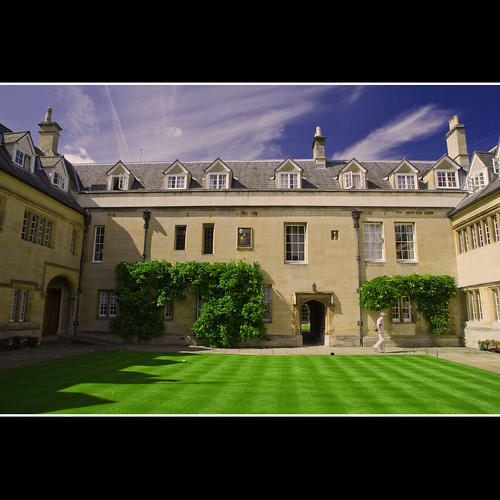Academic preparation
Richard Brett was born either in Somerset or in London, in 1567 , and matriculated at Hart Hall, Oxford, in 1582. He was aged fifteen, and graduated in Classics four years later.
Brett subsequently proceeded MA in 1589, adding a BTh in 1597, and a DTh in 1605.(1) Meanwhile, in 1595 Brett was appointed Rector of Quainton, Buckinghamshire. That same year, he was granted a Fellowship in Lincoln College, under Richard Kilby, where he took up further studies in Hebrew, Aramaic, Arabic, and Ethiopic.
flickr.com
In the 18th Century Lincoln became the cradle of Methodism when John Wesley, a fellow there from 1726, held religious meetings with his brother Charles and the rest of Wesley's 'Holy Club', whom the rest of the university took to calling 'Bible-moths'.
Publications
Brett published translations of hagiography and history from Greek into Latin at Oxford, Vitæ sanctorum Evangelistarum Johannis et Lucæ à Simeone Metaphraste concinnatæ, Oxford, 1597, and Agatharchidis et Memnonis historicorum quæ supersunt omnia,Oxford, 1597 and Iconum sacrarum Decas in quâ è subjectis typis compluscula sanæ doctrinæ capita eruuntur, in 1603.
Translation work
Richard Brett belonged to the first Oxford group, responsible for translating the canonical Old Testament books, Isaiah to Malachi. Its director was John Rainolds, president of Corpus Christi College, Oxford - John had originally proposed the undertaking to King James. Brett was also one of the first fellows of Chelsea College, London, in 1616, Other fellows of this College, who were on the KJV translation committee, include John Overall, John Spenser, Miles Smith and John Boys.
Eminent Reputation
McClure says
He was renowned in his time for vast attainments, as well as revered for his piety. “He was skilled and versed to a criticism” in the Latin, Greek, Hebrew, Chaldee, Arabic, and Ethiopic tongues. This studious and exemplary minister, having attained this exalted reputation, died in 1638, at the age of seventy, and lies buried in the chancel of Quainton Church, where he dispensed the word and ordinances for three and forty years.(2)However, contemporary biographers date Brett’s death as 15 April 1637, not 1638. Over Brett’s grave a monument with his effigies and a Latin and English epitaph was erected by his widow. By his wife Alice he left four daughters. His stone at Quainton, Bucks, shows him, his widow and his four daughters, all kneeling.(1)
Richard Brett's monument
churchmonumentssociety.org
(1) Westbrook, Vivienne Dictionary of National Biography. London: Smith, Elder & Co. 1885–1900. “Authorized Version of the Bible, translators of the (act. 1604–1611).”
(2) McClure, Alexander. (1858) The Translators Revived: A Biographical Memoir of the Authors of the English Version of the Holy Bible. Mobile, Alabama: R. E. Publications (republished by the Marantha Bible Society, 1984 ASIN B0006YJPI8 )



No comments:
Post a Comment